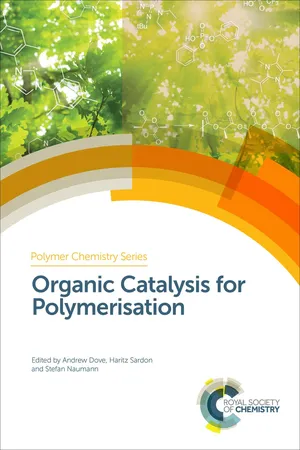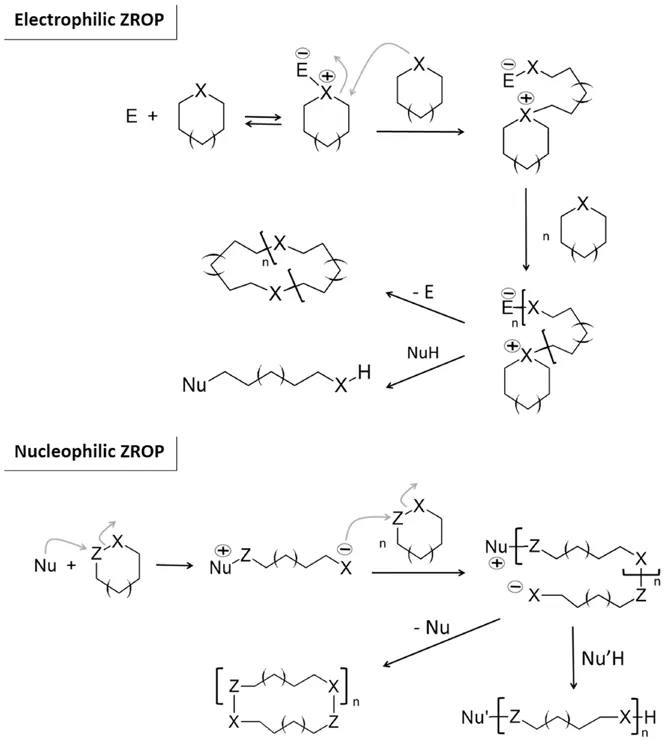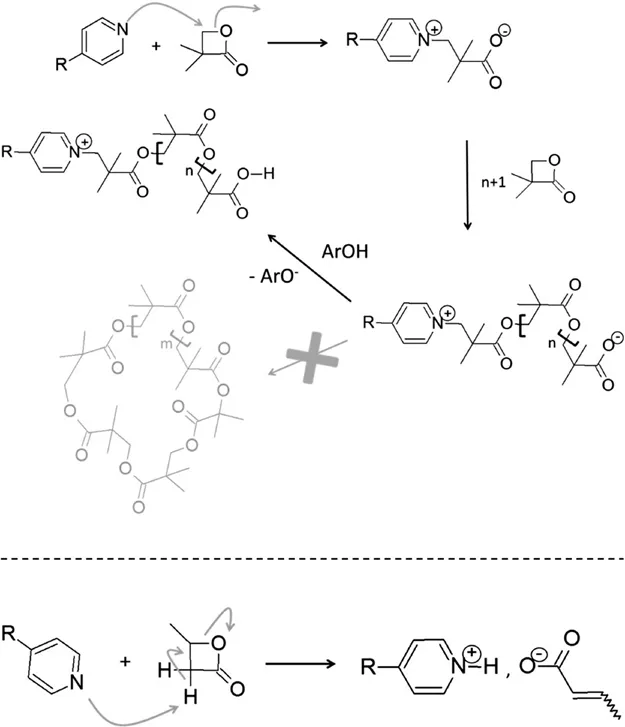![]()
CHAPTER 1
Nucleophilic Catalysts and Organocatalyzed Zwitterionic Ring-opening Polymerization of Heterocyclic Monomers
OLIVIER COULEMBIER
University of Mons, Center of Innovation and Research in Materials and Polymers (CIRMAP), Laboratory of Polymeric and Composite Materials, Place du Parc 23, Mons 7000, Belgium
Email:
[email protected]1.1 Introduction
Organocatalysis refers to a form of catalysis whereby the rate of reaction is increased by an organic molecule preferably used in substoichiometric amounts. The use of organic molecules to perform chemical reactions is not a new concept and organocatalytic reactions look back on a respected history. Both cyanohydrin synthesis from quinine alkaloids1 and proline-catalyzed Robinson annulation2 belong to the most popular dated examples of organocatalytic reactions. Although organic molecules have been used at the beginning of the chemistry, their narrow scope of reactions has not really stirred scientific interest in the past. Nowadays, thanks to clever and sometimes serendipitous discoveries, the picture is changing and organocatalysis is becoming an indispensable part of organic chemistry, offering a wide diversity of reactions, catalysts and processes.3–5
While most of the organo-based reactions concern the enantioselective preparation of small molecules, organocatalysis also offers number of prospects in the polymer community and proposes advantages over metal-based and bioorganic methods.6 In this chapter, special attention is devoted to organocatalyzed ring-opening polymerization (ROP) of cyclic monomers and more especially the zwitterionic ROP (ZROP) from nucleophilic catalysts.
1.2 Definition of ZROP
ZROP is a chain polymerization in which a growing macromolecule bears two ionic chain carriers of opposite signs at its two ends and which usually grows from one of them.7 The zwitterion propagating species—either obtained from a neutral nucleophilic initiator or a neutral electrophile—is initially poorly active since the electrostatic work needed for parting the opposite charged ions is the largest when they are close together. Stabilization of a zwitterionic species may involve the positive end of one zwitterion propagating chain acting as the counter-ion of the carbanion end of another zwitterion propagating chain.8 Termination of the reaction may be caused by the presence of a protic nucleophile or by a charge cancellation step of the highly polar dimer leading to linear and cyclic structures, respectively.9 While neutral electrophiles have already been used in ZROP,10–12 zwitterionic polymerizations typically employ neutral nucleophiles that react with heterocyclic monomer to in situ produce the zwitterionic initiator (Scheme 1.1).
Scheme 1.1 General mechanism of electrophilic (top) and nucleophilic (bottom) zwitterionic ring-opening polymerizations (X and Z represent a heteroatom and an electrophilic site, respectively. Nu and E represent nucleophilic and electrophilic entities, respectively).
To date, several types of organic molecules have been employed as neutral nucleophiles to initiate ZROPs of cyclic monomers. Similarities with simple acylation reactions are unquestionable and allows pyridine-based molecules, imidazoles, amidines, tertiary amines, phosphines and N-heterocyclic carbenes (NHCs) to be used as initiating agents. Considering Scheme 1.1 (bottom of the scheme) as the general way of polymerization, the latent electrophile present on the cyclic monomer (Z) is most of time a carbonyl function. Strained lactones, thiolactones, N-caboxyanhydrides, carbosilanes and cyclic carbonates are then good candidates to undergo nucleophilic ZROP (see Chapter 11).
1.2.1 Pyridine-based Initiation
More than 50 years ago, β-lactones such as β-propiolactone and β-pivalolactone started to be polymerized by pyridine-based nucleophilic initiators.13–16 For several reasons, the course of such ZROP was very complex, involving chain growth and step growth kinetics as well as elimination reactions regarding the type of initiator and monomer used. When moderate bases17 such as pyridine, 4-methylpyridine and 4-(N,N-dimethylamino)pyridine (DMAP) were used for the ZROP of pivalolactone,16 linear chains having one pyridinium ion and a carboxylate ion as end groups were observed by 1H NMR and MALDI-ToF analyses. The absence of cyclic structures suggested that the ZROP proceeded exclusively from the CO2− anion (Scheme 1.2, top). In the case of β-propiolactone and β-butyrolactone (BL), complete elimination of the pyridinium ions and formation of acrylate and crotonate end groups, respectively, were observed (Scheme 1.2, bottom).14,18
Scheme 1.2 Top: ZROP of pivalolactone by pyridine derivatives (R=H, pyridine; R=Me, 4-methylpyridine; R=–N(CH3)2, DMAP); bottom: crotonate formation from proton α-elimination of β-butyrolactone induced by pyridine.
The catalytic potential of donor-substituted pyridines is well established since the report on DMAP by Litvinenko et al. in 1967 and by Steglich et al. two years later.19,20 A catalytic improvement was reported in 1978 for 4-(pyrrolidinyl)pyridine (PPY),21 and in 2003 with 9-azajulolidine.22 Annelated pyridine derivative is a powerful organocatalyst not only suitable for acylation reactions, but also for other transformations such as the aza-Morita Baylis Hillman reaction.23
The commercially available DMAP catalyst is often the common choice for acylation reactions proceeding by a nucleophilic mechanism involving an acyl pyridinium ion intermediate (Scheme 1.3). The amplified reactivity of aminopyridine derivatives—up to four orders of magnitude higher than pristine pyridine in representative acyl transfer17,24—may come from the greater equilibrium concentration of the acyl pyridinium intermediate and its increased electrophilicity because of looser ion pairing.25–28
Scheme 1.3 Proposed mechanism for a DMAP-catalyzed acylation reaction. Simplification of the mechanism proposed by Spivey in [25].
In 2001, Hedrick et al. demonstrated that Lewis basic amines such as DMAP and PPY were highly effective for the ROP of lactide (LA) monomers.29 Although other works on metal-free processes were publishe...



